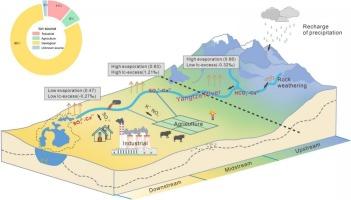Determining the evaporation and evolution of surface water in a large catchment using isotopes and multiple models
IF 3.5
3区 环境科学与生态学
Q2 ENVIRONMENTAL SCIENCES
引用次数: 0
Abstract
The evolution and formation mechanisms of chemical components in surface water can reflect changes in the geological background of a basin and the extent of human interference. The Yangtze River basin is the largest water source area in China, yet its main ion sources and formation mechanisms are not fully understood. This study uses a combination of hydrochemistry, stable isotopes (δ18O, δD), the Craig-Gordon model, and the APCS-MLR model to quantitatively assess the water source replenishment and evaporation intensity of surface water in the Yangtze River. The study reveals the primary ion sources and controlling factors of surface water in the Yangtze River. The results show that the hydrochemical type in the upstream is mainly HCO3−-Ca2+ and Na+-K+, while in the midstream and downstream it is primarily HCO3−-Ca2+ and SO42−-Ca2+. The evolution of hydrochemical types is mainly controlled by rock weathering and human inputs. The surface water sources in the Yangtze River are directly replenished by precipitation, with the evaporation ratio in the upstream (0.66) being higher than in the midstream (0.63) and downstream (0.47). The lc-excess in the upstream (−0.32 ‰) is lower than in the midstream (1.21 ‰) and downstream (−0.27 ‰), indicating more intense evaporation in the upstream. The hydrochemical composition of the Yangtze River surface water mainly comes from geological factors (80.5 %), industrial factors (11.1 %), agricultural factors (6.4 %), and unknown factors (2.0 %). This study enhances the understanding of the chemical composition, water source replenishment, ion sources, and evolution mechanisms of the Yangtze River surface water, providing a basis for maintaining water quality and sustainable development in the Yangtze River basin.

利用同位素和多种模型确定大型集水区地表水的蒸发和演变。
地表水中化学成分的演变和形成机制可以反映流域地质背景的变化和人为干扰的程度。长江流域是中国最大的水源区,但其主要离子源和形成机制尚未完全清楚。本研究结合水化学、稳定同位素(δ18O、δD)、Craig-Gordon 模型和 APCS-MLR 模型,对长江地表水的水源补给和蒸发强度进行了定量评估。研究揭示了长江地表水的主要离子源和控制因子。结果表明,上游水化学类型主要为 HCO3--Ca2+和 Na+-K+,中下游主要为 HCO3--Ca2+和 SO42--Ca2+。水化学类型的演变主要受岩石风化和人为输入的控制。长江地表水源由降水直接补充,上游蒸发比(0.66)高于中游(0.63)和下游(0.47)。上游的 lc-过量(-0.32‰)低于中游(1.21‰)和下游(-0.27‰),表明上游的蒸发更为强烈。长江地表水的水化学组成主要来自地质因素(80.5%)、工业因素(11.1%)、农业因素(6.4%)和未知因素(2.0%)。该研究加深了人们对长江地表水化学成分、水源补给、离子来源和演变机理的认识,为保持长江流域水质和可持续发展提供了依据。
本文章由计算机程序翻译,如有差异,请以英文原文为准。
求助全文
约1分钟内获得全文
求助全文
来源期刊

Journal of contaminant hydrology
环境科学-地球科学综合
CiteScore
6.80
自引率
2.80%
发文量
129
审稿时长
68 days
期刊介绍:
The Journal of Contaminant Hydrology is an international journal publishing scientific articles pertaining to the contamination of subsurface water resources. Emphasis is placed on investigations of the physical, chemical, and biological processes influencing the behavior and fate of organic and inorganic contaminants in the unsaturated (vadose) and saturated (groundwater) zones, as well as at groundwater-surface water interfaces. The ecological impacts of contaminants transported both from and to aquifers are of interest. Articles on contamination of surface water only, without a link to groundwater, are out of the scope. Broad latitude is allowed in identifying contaminants of interest, and include legacy and emerging pollutants, nutrients, nanoparticles, pathogenic microorganisms (e.g., bacteria, viruses, protozoa), microplastics, and various constituents associated with energy production (e.g., methane, carbon dioxide, hydrogen sulfide).
The journal''s scope embraces a wide range of topics including: experimental investigations of contaminant sorption, diffusion, transformation, volatilization and transport in the surface and subsurface; characterization of soil and aquifer properties only as they influence contaminant behavior; development and testing of mathematical models of contaminant behaviour; innovative techniques for restoration of contaminated sites; development of new tools or techniques for monitoring the extent of soil and groundwater contamination; transformation of contaminants in the hyporheic zone; effects of contaminants traversing the hyporheic zone on surface water and groundwater ecosystems; subsurface carbon sequestration and/or turnover; and migration of fluids associated with energy production into groundwater.
 求助内容:
求助内容: 应助结果提醒方式:
应助结果提醒方式:


